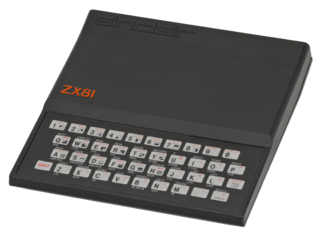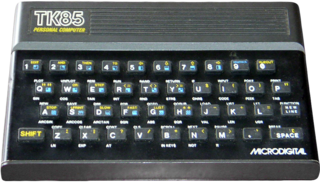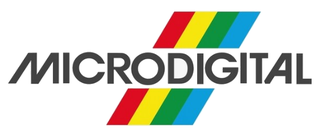The Sinclair QL is a personal computer launched by Sinclair Research in 1984, as an upper-end counterpart to the ZX Spectrum.

The Sinclair ZX80 is a home computer launched on 29 January 1980 by Science of Cambridge Ltd.. It is notable for being one of the first computers available in the United Kingdom for less than a hundred pounds. It was available in kit form for £79.95, where purchasers had to assemble and solder it together, and as a ready-built version at £99.95.

The ZX81 is a home computer that was produced by Sinclair Research and manufactured in Dundee, Scotland, by Timex Corporation. It was launched in the United Kingdom in March 1981 as the successor to Sinclair's ZX80 and designed to be a low-cost introduction to home computing for the general public. It was hugely successful; more than 1.5 million units were sold. In the United States it was initially sold as the ZX-81 under licence by Timex. Timex later produced its own versions of the ZX81: the Timex Sinclair 1000 and Timex Sinclair 1500. Unauthorized ZX81 clones were produced in several countries.
The Didaktik was a series of 8-bit home computers based on the clones of Intel 8080 and Zilog Z80 processors produced by Didaktik in Skalica, in the former Czechoslovakia.

The TK90X was a Brazilian ZX Spectrum clone made in 1985 by Microdigital Electrônica, a company from São Paulo, that had previously manufactured ZX80 and ZX81 clones.

The TK 95 microcomputer was a 1986 ZX Spectrum clone by Microdigital Eletrônica, a company located at São Paulo, Brazil. It was an evolution of the TK90X introduced the previous year.

The CP 400 COLOR was launched in 1984 by Prológica, a Brazilian company which made clone versions of various computers, under the general designation of "CP".

The Timex Computer 2048 or TC 2048 is a 1984 computer developed by Timex Portugal, at the time part of Timex Sinclair. It was based on the Timex Sinclair 2048 prototype, with a similar redesign case, composite video output, Kempston joystick interface, and additional video modes, while being highly compatible with the Sinclair ZX Spectrum computer.

The TK85 was a ZX81 clone made by Microdigital Eletrônica, a computer company located in Brazil. It came with 16 or 48 KB RAM, and had a ZX Spectrum–style case, similar to a Timex Sinclair 1500.

Ringo R-470 was a Brazilian clone of the Sinclair ZX81 by Ritas do Brasil Ltda. introduced in 1983. It featured a Z80A processor at 3.25 MHz, 8K ROM and 16 KB RAM. It wasn't 100% compatible with the ZX81, and some BASIC tokens have alternate codings.

Microdigital Eletrônica Ltda. was a Brazilian computer company in the 1980s, based in São Paulo.

The CP 200 was a Brazilian home computer produced by Prológica in 1982.

The NE-Z8000 is a Brazilian homebuilt computer clone of the Sinclair ZX81, introduced in late 1982 by Prológica's subsidiary, the monthly magazine Nova Eletrônica.
The TK80 was a home computer produced by Microdigital Eletrônica. A clone of the Sinclair ZX80, it was introduced along with the TK82 in 1981 during the "I Feira Internacional de Informática". There were two versions, one with 1 KB RAM costing Cr$ 68,850 and another with 2 KB costing Cr$73,650.

The AS-1000 was a Brazilian clone of the Sinclair ZX81 introduced by Engebrás Eletrônica e Informática Ltda in October 1983. The main differences regarding the ZX81 are the internal power supply and larger RAM. The machine had an initial retail price of Cr$ 195 000.
The TK83 was a home computer produced by the Brazilian company Microdigital Eletrônica Ltda. and introduced in August 1982. By December 1984, it was no longer being advertised by Microdigital, being discontinued in 1985.

The TK 2000 microcomputer, produced by the Brazilian company Microdigital Eletrônica Ltda, was presented to the public during the 1983 Computer Fair and launched in 1984. It was a clone of the Microprofessor II manufactured by Multitech. Based on the 6502 CPU, the machine was partially compatible with Apple II Plus software and hardware. Some software was developed specifically for the machine, including productivity programs and games.
TK82 was a Sinclair ZX80 clone made by Microdigital Eletrônica Ltda., a computer company located in Brazil. It was introduced along with the TK80 in 1981, during the "I Feira Internacional de Informática".














